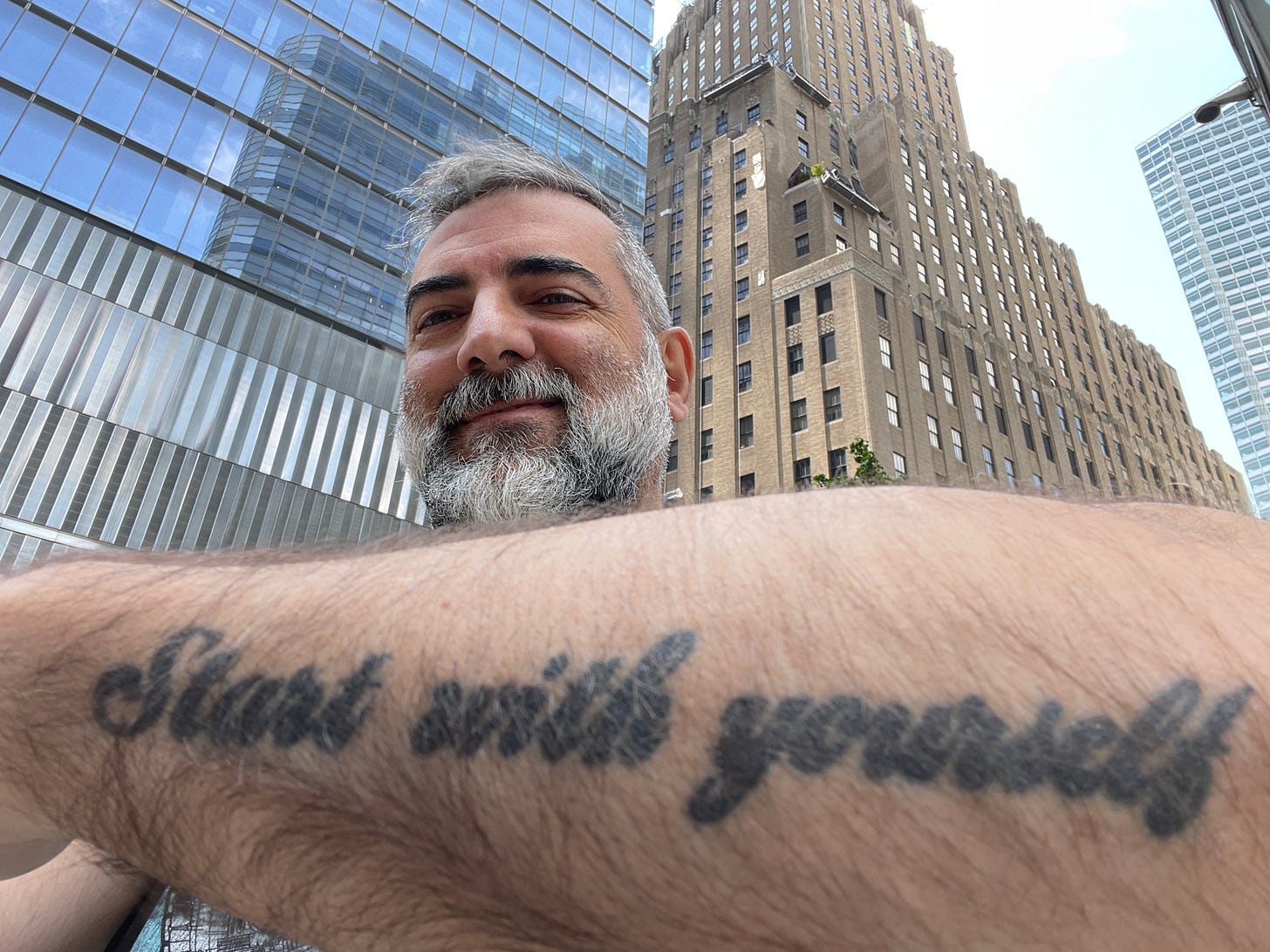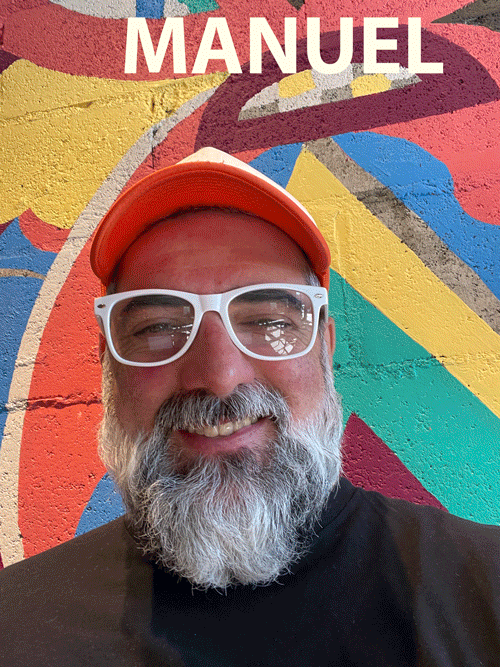Start With Yourself
Because You Are the Most Important Person in Your Universe
I'm Manuel Saez, I write to help founders master emotional intelligence to make decisions with clarity and confidence 🌻 EQ coach, 2X-founder & award-winning designer ➜ I love fixing old motorcycles 🛵 🏍
You are the most important person in your universe.
It is paradoxical that when you put yourself first, you become the best version of yourself for those around you.
It might seem counterintuitive, and many people might see it as selfish.
Still, the reality is that the more you love and respect yourself, the better you are for everyone else.
Parents, teachers, nurses, founders, and people in positions of service tend to give it all for the people they are supporting, helping, or serving.
This is understandable, but it may harm them in the long run.
When we put ourselves first, we are much better positioned to help and support others.
More importantly, we have clarity and are in a place where we do things to the best of our abilities, and we can live life to our fullest potential.
To me, success is not about money, building a big company, or being in a position of power.
True success is to be in alignment with yourself.
I believe in this so much that I have a tattoo that reads "Start With Yourself," a constant reminder to always seek that self-alignment.
This essay is a collection of insights and experiences I've gathered over the years, aiming to help you prioritize self-care and find that crucial self-alignment.
When you are in true alignment with yourself, you become unstoppable.
The Founder's Journey Begins Within
Founding a startup is one of the hardest things I have done.
It is filled with very rewarding highs and profound lows.
It is a journey in which you give it all, and sometimes, that means sacrificing your well-being for the job. That is a mistake I made.
When I was younger, I thought working harder or "doing more reps" was the answer to hard problems.
Sometimes, that worked, but most of the time, it didn’t.
With time, I learned that when I don't take care of my well-being, both physical and mental, things get worse.
Things started happening for me when I took care of myself, but more importantly, when I enjoyed the journey.
Taking time to nurture ourselves isn't a luxury; it's a necessity.
Simple practices like setting boundaries, prioritizing sleep, and taking breaks can make a difference.
Setting boundaries was particularly challenging for me.
I felt guilty for not always working, but I learned that I couldn't sustain the energy needed for my business without these boundaries.
Prioritizing sleep was another game-changer. I used to think I could get by on five hours of sleep, but I was wrong.
Now, I aim for eight hours each night, and the difference in my energy levels and focus is astounding.
Recognizing the Inner Critic
The inner critic is that nagging voice in our heads, always quick to point out our flaws and mistakes.
For many of us, this voice can be particularly harsh. I call mine "Pedro."
Pedro loves to show up when I'm already feeling down, reminding me of every failure and misstep.
This voice often originates from past experiences with critical figures in our lives, like parents or teachers.
Recognizing this “critic” is the first step in managing it.
When Pedro starts talking, I acknowledge him but don't let him take control.
Instead, I invite him to the table along with other supportive voices, like my Protector and Warrior. These voices remind me of my strengths and achievements.
Here's how you can do the same:
Awareness: Identify the voice and pay attention to when the inner critic speaks. Do not judge; just note the situations and triggers.
Understand when and why this voice comes up. This step is crucial because it allows you to see patterns and recognize that this voice is not your true self but a response to specific stressors or situations.Acceptance: Instead of fighting the voice, acknowledge its presence. Tell yourself, "I hear you, but you don't define me." This approach reduces the power of the inner critic.
Accepting its presence prevents the inner struggle from becoming more intense. Acceptance allows you to move forward without being bogged down by negativity. (more on this below)Gratitude: Recognize that the voice means well; it wants to protect you. Be grateful to have it because, at some point, it helped you navigate difficult situations.
This gratitude helps reframe your relationship with the inner critic, seeing it as a misguided attempt at protection rather than an enemy.Listen to Your Gut: Don't take Pedro as the only voice. Seek the other voices in your head, especially the one that speaks from your gut, your intuition. This voice is connected to your best self.
With all the voices having spoken, you can make a well-rounded decision. Your intuition often has insights that the critic overlooks, providing a more balanced perspective.
Combining these voices helps you make decisions that are rational and aligned with your true self.
This acknowledgment helps me separate my self-worth from his harsh words. By recognizing and understanding the inner critic, we can begin to manage it more effectively.
Embracing the Critic
Instead of fighting the inner critic, I've learned to accept it. Fighting only gives it more power.
Accepting Pedro means recognizing that he's part of me but doesn't define me.
I imagine sitting at a table with Pedro and the other supportive voices in my head, and having a discussion.
You gain a protector by accepting and allowing the critic to be part of the conversation.
This approach allows us to understand the origins of the inner critic and manage it more effectively.
It's about balancing the dialogue in our heads, not letting the critic overshadow the positive voices that support and uplift us.
Here's a process to help embrace self-acceptance:
Invite Supportive Voices: Imagine your supportive voices, like the Protector and Warrior, joining the conversation. What would they say? These voices can provide balance and remind you of your strengths and achievements.
Balance the Dialogue: Ensure the positive voices are as loud as the critic. Regularly acknowledge your strengths and achievements. This helps maintain a balanced perspective and prevents the critic from dominating your thoughts.
Practice Self-Compassion: Treat yourself with the same kindness and understanding you would offer a friend. Self-compassion involves recognizing your humanity, being kind to yourself, and understanding that making mistakes is part of being human.
This balance helps me maintain a healthier inner dialogue and confidently move forward. Embracing the critic doesn't mean agreeing but understanding its presence and balancing it with positive, supportive voices.
Cultivating a Supportive Inner Team
Building a supportive inner team involves nurturing the positive voices in our heads alongside our inner critic.
For me, these voices include my Protector, Warrior, Cheerleader, and Wiser-self. Each plays a crucial role in maintaining a balanced inner dialogue.
My Protector reminds me to set boundaries.
This voice ensures that I don't overextend myself and helps me prioritize self-care. Setting boundaries was challenging for me initially, but listening to my Protector has helped me maintain my energy and focus.
My Warrior encourages me to take bold steps and face challenges head-on.
This voice provides the courage and determination needed to push through obstacles and pursue my goals with vigor. My Warrior has been instrumental in helping me overcome fears and take calculated risks.
My Cheerleader celebrates my achievements, no matter how small.
This voice provides positive reinforcement and reminds me of my strengths and successes. By acknowledging my accomplishments, my Cheerleader helps boost my confidence and motivation.
My Wiser Self is the version of myself that is connected with the universe and mediates everything.
This voice offers wisdom, perspective, and a sense of calm. My Wiser Self helps me see the bigger picture and guides me to make thoughtful decisions.
To cultivate these voices, I practice journaling and visualization.
Journaling helps me process my thoughts and gain clarity. Writing down my feelings and reflecting on my experiences allows me to see patterns and understand my emotions better.
Visualization techniques also play a crucial role. I spend a few minutes each day visualizing my success, seeing myself achieving my goals, and reinforcing positive self-belief.
Balancing these supportive voices with the inner critic creates a healthier inner dialogue. It's a continuous process that empowers me to face challenges with confidence and resilience.
Let's recap the most important takeaways:
Start With Yourself: Prioritize self-care. It's not a luxury but a necessity for sustaining energy, creativity, and resilience.
Recognize the Inner Critic: Identify the inner critic's voice, acknowledge its presence, and understand its origins.
Embrace Self-Acceptance: Balance the dialogue in your head by inviting supportive voices like the Protector, Warrior, Cheerleader, and Wise self.
Cultivate a Supportive Inner Team: Nurture the positive voices in your head to maintain a balanced inner dialogue and build confidence.
Remember, self-love is a continuous journey, and it starts with you.
Sending you good vibes 🌻
Manuel





